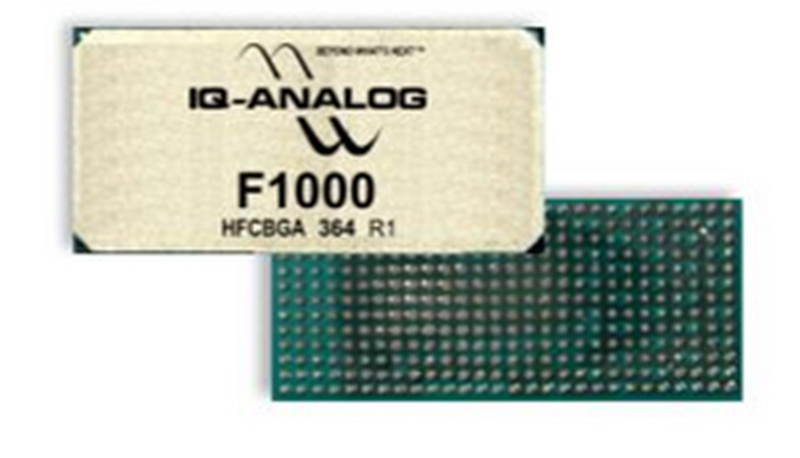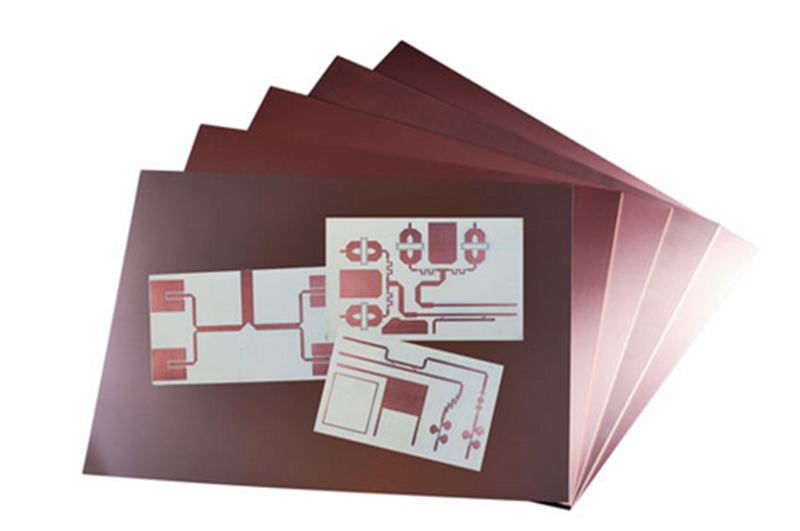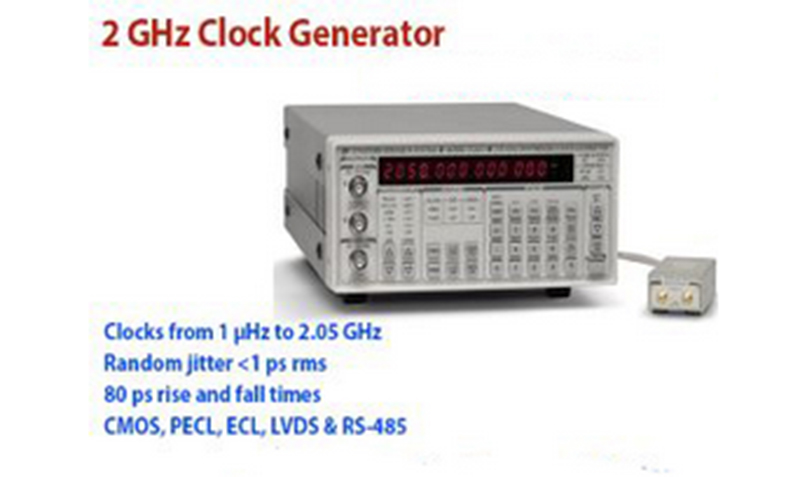Printed circuit board (PCB) circuit materials are the critical building blocks of RF/microwave circuits - essentially where these circuits begin. PCB materials come in many different forms, and the choice of material is highly dependent on the requirements of the intended application. For example, materials that reliably support high-frequency circuits in commercial wireless products can fail rapidly when subjected to the extremes of a military environment. A basic understanding of the PCB material type and its parameters can help match the material to the application.
As with many RF/microwave components, PCB materials are categorised and compared by a number of key parameters, including relative dielectric constant (Dk or εr), dissipation factor (Df), coefficient of thermal expansion (CTE), dielectric heat coefficient constant (TCDk) and thermal conductivity. When categorising different PCB materials, many circuit designers start with Dk. The Dk value of a PCB material is the capacitance or energy available between a pair of conductors made very close to each other on the material compared to the same pair of conductors in a vacuum.
A reference value of 1.0 is used for vacuum generation, while other dielectric materials provide higher reference values. For example, commercial PCB materials typically have Dk values in the range of about 2 to 10, depending on how they are measured and how often they are tested. Conductors on materials with higher Dk values can store more energy than conductors on materials with lower Dk values.

The Dk value of a PCB material affects the size, wavelength, and characteristic impedance of the transmission line manufactured on that material. For example, for a given characteristic impedance and wavelength, the size of a transmission line made of a PCB material with a high Dk value will be much smaller than the size of a transmission line made of a PCB material with a low Dk value, even though other material parameters may be different. Designers of circuits where loss is a critical performance parameter often prefer to use PCB materials with lower Dk values because they have lower loss than materials with higher Dk values.
In practice, PCB materials can lose signal power in four ways: dielectric loss, conductor loss, leakage loss, and radiated loss, although dielectric and conductor losses can be better controlled by the choice of PCB material. For example, the Df parameter provides a way to compare the dielectric loss of different materials, where a lower Df value indicates a material with lower dielectric loss.
For a given transmission line impedance (e.g., 50 Ω), the transmission line on a low Dk material will be physically wider than that on a high Dk material, and the wider line will have less conductor loss. These wider transmission lines also translate into higher manufacturing yields (and production cost savings) than narrower transmission lines in higher Dk materials. However, the trade-off is that they take up more area on the PCB, which can be a problem for designs where miniaturisation is critical.The thickness of the PCB substrate, particularly its copper conductor layer, also affects the impedance of the transmission line, with thinner dielectric materials and conductors resulting in narrower conductor widths in order to maintain the required characteristic impedance.
Conductors in PCB materials are usually specified in terms of copper weight, such as 1 oz. (35 µm thick) copper or 2 oz. (70µm thick) copper. The quality of these copper conductors also affects conductor loss. Copper conductors with rough surfaces will exhibit higher conductor losses than copper conductors with smooth surface profiles.
Maintaining the impedance of the transmission line is critical for many RF/microwave circuits, so keeping Dk within a narrow range across the PCB and varying with temperature is critical to achieving tight impedance in the design. Most PCB datasheets show the Dk of the material and its Dk tolerance, e.g. ±0.5.
Another important material parameter, TCDk, provides detailed information on how much the Dk of the PCB material varies over the operating temperature range, as this also affects the impedance of the transmission line. a TCDk value of 150 ppm/°C may be considered high, while a TCDk value of 30 ppm/°C or less is considered very low. For circuits that must maintain impedance over a wide operating temperature range, it is best to use PCB materials with lower TCDk values.
In addition to temperature changes affecting Dk and impedance, they also have a mechanical effect on the PCB. the CTE of a PCB is a parameter that attempts to show the effect of temperature on the PCB material. Essentially, it is a measure of the expansion/contraction of the material with temperature, with the lower value being the target. For example, although pure PTFE has a high CTE (~300 ppm/°C), materials such as polytetrafluoroethylene (PTFE) have long been used in high-frequency PCBs due to their excellent electrical properties.
Some PCB material manufacturers, for example, use PTFE in their materials but add different filler materials to reduce the CTE values (see photo). It is important to note that the CTE of a PCB dielectric material should be closely matched to the CTE of its conductors and other layers to minimise the mechanical effects of temperature changes.

This ceramic-filled PTFE composite, RT / duroid 6035HTC, has high thermal conductivity for high-power circuit applications.
For any commercially available PCB material, individual CTE values are usually listed for all three axes (x, y and z). CTE provides some evidence of how the PCB material handles extreme temperatures, for example during soldering. For example, mismatched CTE values for materials used in multi-layer constructions can lead to reliability problems as the dimensions of the different circuit layers vary with temperature. PCB materials with lower CTE values are generally considered to be more thermally stable than those with higher CTE values. For use over a wide temperature range, a circuit material with a CTE of 70 ppm/°C is considered to be quite robust and should be able to cope with the extreme temperatures of circuit fabrication and assembly.
The CTE of the PCB material should be closely matched to the CTE of the copper in the x and y axes to minimise the variation of mechanical stress with temperature. Additionally, the CTE of the circuit material in the z-axis provides insight into the expected reliability of the plated through holes (PTHs) that will be formed through the dielectric material, as these drilled holes are plated with copper. Ideally, the dielectric material and copper will expand and contract with temperature in a similar manner to achieve the high reliability of the PTH.
Heat dissipation in RF/microwave circuits, especially for high power designs, is an important function characterised by the thermal conductivity of the PCB. Although standard PCB materials may have a thermal conductivity of 0.25 W/m/K, it is common to add fillers to the PCB material to increase the thermal conductivity to more favourable values (as well as better heat dissipation). For example, RO4350B, Rogers' hydrocarbon/ceramic PCB material, has long been a reliable building block material for high-frequency applications including automotive and cellular communication systems.
RO4350B is not PTFE-based, but has a relatively low z-axis Dk of 3.48 ± 0.05 at 10 GHz, a TCDk of +50 pm/°C, and a dissipation factor of 0.0037. It has a reasonably good thermal conductivity of 0.69 W/m/K. In contrast, RT/duroid 6035HTC, also from Rogers, is a ceramic-filled PTFE composite material specially formulated for high-power, high-frequency circuits, with a Dk of 3.50 ± 0.05, a TCDk of +50 ppm/°C. It has a low dissipation factor of 0.0013. It has excellent thermal conductivity with a typical value of 1.44W/m/K.

There is a wide range of materials used in RF/microwave PCBs, from low-cost FR-4 materials to expensive PTFE-based materials. PCBs composed of FR-4 materials are essentially glass-reinforced epoxy laminates, whereas PTFE materials are usually reinforced with glass fibre or ceramic filler materials (although pure PTFE-based PCBs are also used). The difference in performance between these two extreme materials points to the trade-offs that PCB materials must make between cost and performance, and between the ease of processing FR-4 and the difficulty of processing PTFE materials.
Excellent circuit performance usually comes at a high price, although many PCB material suppliers have invested significant effort in developing a variety of composite materials with different Dk values for use in a variety of RF/microwave applications.